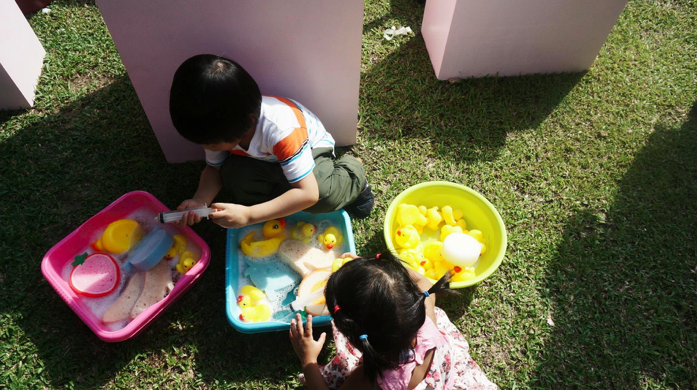Johnson’s and child development experts rally for
active sensorial play to enhance a child’s holistic development

In a society where tech companies try to outdo each other on a regular basis comes the massive proliferation of gadget use across all walks of life. With 36% of Filipinos having about 10 gadgets per household*, gadgets have undoubtedly become a necessity for daily living. At home, gadgets have turned into toys given by parents to their kids – in fact, kids today start tapping on tablets and smartphones as early as nine months old. Believing digital acumen to be an advantage, giving kids the latest gadgets has been a way for parents to give them so much more.
Admittedly, gadget play can teach children so many things, like colors and the alphabet. However, it is through active sensory play that all their five senses are awakened to discover and learn about the world around them. This has been proven by Johnson’s Baby in a social experiment to see how children engage in gadget play versus real play. Captured in a heartwarming film, this initiative has unveiled the wonders of learning using the five senses through active play – as witnessed by the moms themselves.
“As a brand committed to the happy, healthy development of children, we at Johnson’s believe that every activity that a child does can mean so much more to him,” says Trina Tanlapco, Johnson’s Associate Marketing Director. “Active play is integral and essential in the holistic development of children to let them discover the world around them. As a brand, this is something we would like to keep reminding parents of. With the information and products we offer, parents can let their children turn playtime to a time of learning while they #playforreal.”
Apart from fostering the bond between parent and child, it is during active play when all five senses of the child are engaged, making her more receptive to the things that surround her. According to Fiona Sandoval, a licensed clinical psychologist and play therapist, a child reaps the maximum benefits of active play when her senses are enhanced and maximized in these activities. “The brain grows up to 90% of its adult size from birth up to five years old. It is important that all the different senses get stimulated in activities like active play during this period so that the neurons and brain connections are formed better. If this is achieved, there will be more synapses and connections, which can optimize the brain development.”
“In sensory play, children develop their fine motor, language and cognitive skills. The stimulated senses work hand in hand in helping a child achieve holistic development,” she adds.
Monica Javier, a teacher who has worked with preschool children for more than ten years, also adds that active sensorial play help children prepare for bigger things ahead of them which is why it is encouraged to be integrated in early education. “More than fun and entertainment, play actually helps children to expand their knowledge about themselves, allows communication with others, develop new competencies that may prepare them for challenges of the bigger environment.”
In school, sensorial activities are used to teach children about different concepts. For example, encouraging them to play and explore with blocks allow children to distinguish shapes, sizes and weight; it also encourages them to plan strategically. Providing opportunities to paint with different implements or with their body develops creativity and teaches them about colors and textures. Running, jumping, crawling or any form of movement can help them develop gross motor skills. Pretend play in these areas encourages communication among them. These are things that tapping on a gadget cannot teach.
“Sensory activities allow children to go through a scientific process in a very natural way. While playing, they ask questions, predict, make hypothesis, test hypothesis and make conclusions,” shares Javier.
For mom Kris De Guzman, a mother of two, introducing sensory play to her children balances out their time from other forms of play. It also makes them more imaginative, creative, and resourceful in the activities that they do together. “At home, bath time is also playtime for my kids. We play with bubbles, make up stories, and learn about body parts. Through simple activities like this, we are able to make enjoyable moments together and strengthen our connection toward each other,” says de Guzman.
Indeed, playtime can mean so much more, so let your kids #playforreal. To learn more about how you can do sensory play at home or in your school, visit https://www.facebook.com/JohnsonsBabyPhilippines.
*Survey conducted by Microsoft Philippines in 2011
ADVT